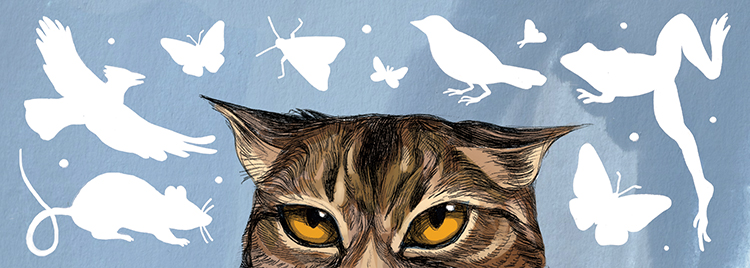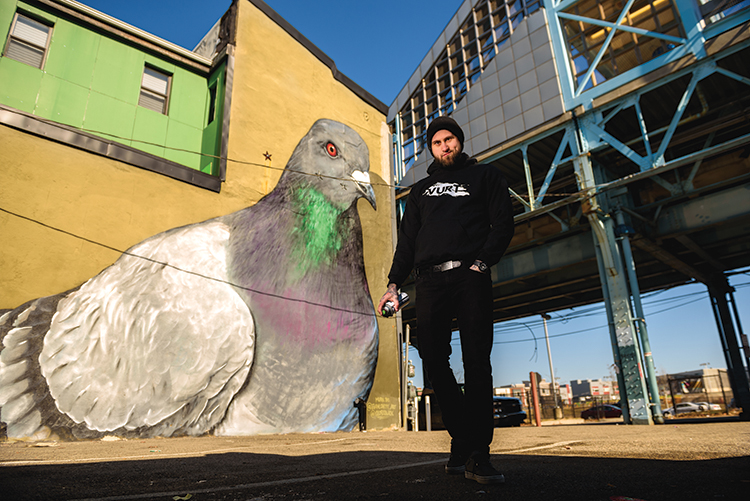It sure seems generous and altruistic to take care of a stray cat. It is, on the face of it, a noble activity. Confronting the consequences, however, isn’t easy.
Birds, small mammals, butterflies—all can end up in the jaws of a domestic cat. Even well-fed domestic cats keep killing smaller creatures for fun, as cat owners know. Hunting might be a natural cat behavior, but there is nothing natural about how our house cats hunt. We’re talking about an exotic species in the Americas that has not evolved alongside our wildlife. And of course we feed cats, boosting their population densities far higher than anything our native critters ever see from natural predators. The effect is disastrous, and a robust body of scientific research backs this up. The domestic cat is responsible for killing at least 1.3 billion birds and at least 6.3 billion mammals in the contiguous United States every year, according to a 2013 study published in the science journal Nature Communications. Outdoor cats’ habits vary, but on average each one kills about 24 birds and 160 mammals per year. And there are a lot of unowned cats in Philadelphia (not counting the pets allowed outside)—estimates range higher than 300,000. Even if we make the conservative assumption that our urban cats have less killing opportunity than their rural counterparts, that’s still a lot of dead birds and bunnies—a lot of wildlife that Philadelphians won’t experience.

And when it comes to birds, how we manage our cats affects our neighbors all over the hemisphere. Our common yellow-throats—charismatic warblers that breed in our wetlands—winter in Central America. The dark-eyed juncos that spend their winters in our gardens breed in northern forests. And scores of other species visit Philadelphia for only a few days on their way along the Atlantic flyway. Every time a cat kills a magnolia warbler or an olive-sided flycatcher in Philadelphia, it is an international loss.
Cat advocates (and the multimillion-dollar lobbying groups behind them, such as Alley Cat Allies) claim that trapping, neutering and releasing (TNR) unowned cats will reduce their population over the long term. Although this might work in small, isolated areas with particularly dedicated caretakers, it is a futile effort on the scale of a city like Philadelphia. A few missed female cats can produce a lot of kittens, and colonies are magnets for irresponsible cat owners who would rather abandon pets than do the work of finding them a home.
Cat advocates also often claim that more cats will fill in when we remove colonies of unowned cats (the “vacuum effect”). These claims completely ignore the active human role in this process. Stray cats wouldn’t hang out on your block if it weren’t for the guy who gives them some tuna every night, and the same goes for larger colonies. It might be impossible to completely remove cats from the urban landscape, but we can do a lot more to shrink the population and reduce their impact.
Grid readers know that living in a city doesn’t mean giving up on nature: a mockingbird’s serenade from the roof of a rowhouse, a monarch butterfly drinking from a flower, the antics of chipmunks in the garden. All provide wild experiences in our daily lives. This is true whether you have the privilege to escape to a “wild” place on the weekends or if you’re a 10-year-old whose entire world is her neighborhood.
Those who care for unowned cats do so with the best intentions, but sadly there is no such thing as a no-kill solution. What we can do is keep our pets inside, and we can trap strays to remove them from the landscape. Even if that means we euthanize some of them, we save lives. More than that, we do our part to keep nature around our city: for ourselves and for our neighbors.
Bernard “Billy” Brown co-hosts the Urban Wildlife Podcast. He also volunteers as the Philadelphia coordinator for the Pennsylvania Amphibian and Reptile Survey.







I second Mr. Brown’s comments on feral cats, and add some additional arguments against toleration of free-roaming or stray cats, a tragedy supplemented by the unnecessary addition of TNVRed cats (trapped, neutered, vaccinated-one-time-with-no-essential-boosters, re-abandoned on to the streets to live a brutal short life and die in agony from disease, infection, trauma, predation, poison and unspeakable cruelty from sadistic or fed-up humans. EVERY CAT DESERVES A LOVING HOME AND/OR HUMANE EUTHANASIA.
Feral cat colonies often grow to populations of 100s. They attract wildlife to their food, then spread disease to the wildlife, and to our pets, and to humans. Google "CDC Burden of Rabies", "CDC toxoplasmosis biology" (a brain-invading parasite that only reproduces in intestines of felids and is implicated in miscarriage, fetal deformity, blindness, schizophrenia, suicide, dementia, and death for the immunocompromised) and "CDC toxocariasis"
Animal control was created to protect human health, not to prolong unhappy lives of stray cats. Indoor cats live, on average, a decade longer than ferals. There is a good reason that four times as many humans need post-exposure rabies shots from cat exposure as from dog exposure: we don’t support feral dog colonies. Every health department from the CDC down advises to call animal control to remove strays. Animal control, please do your job! Cat-owners, please, for the sake of cats/pets/people/wildlife, keep your cats indoors!
Very well said Mr. Brown. We all want to be compassionate but we need to look at the big picture and realize there is a steep price to be paid if keeping every single feral cat alive is the priority. We should all do our part — trap and remove free-roaming cats. Find indoor homes for as many of those that are suitable as possible. Give the rest a painless death.
Thank you for writing this! Spot on. The Mayor is caught up in the feel-good nonsense of the so-called no-kill movement. Instead, he needs to make the green spaces of Philly stay that way for residential and migratory wildlife. And, he needs to make public health and welfare the priority – not ‘saving’ cats at the expense of everything else.
You should focus on real human absurdities like Afghanistan war and urban gun violence get real and tackle real problems leave the cats do evolutionary acts get real
Thank you for your very well written and thoughtful analysis. Too many people think only about the immediate need of the"poor little kitty" while ignoring the devastation the kitty inflicts on all sorts of other animals, and on people, particularly children. I wish people who feed stray cats would look beyond their own noses, and beyond the warm happy Lady Bountiful feeling they get from feeding stray cats, and look at the whole situation. Perhaps your article will help. Thank you again.
Best Friends and HSUS are also promoting the irresponsible re-dumping and feeding of feral cats, rather than responsibly neuter and rehome if socialized, or humanely euthanize, to spare the wildlife and maintain our first world public health standards. Feral cats have the highest rates of Toxoplasma gondii (versus indoor only, fed fully cooked food) and spread it in their feces to other warm blooded animals, including humans. It is transmitted in dust by inhalation or ingestion, and can even foul water supplies and anything downstream or where the storm drains dump out. Good article, glad to see it.
Best, Johanna van de Woestijne, Stanford Med
Isn’t that horrible when a species dominates it’s landscape to it’s own benefit with complete disregard for the overall ecosystem. It needlessly kills other species for no good reason as it can be fed in other ways. It has no natural predators and it’s population is bolstered dramatically through medical care and social structures that help it thrive despite it being a nuisance to the planet.
See what I did there? 🙂
It’s hard to take this too seriously when another species is orders of magnitudes more damaging to wildlife.
The reason you have little wildlife, birds, butterflies, etc in Philadelphia is because you are a filthy people! Look at the garbage everywhere with the exception of the wealthiest neighborhoods! You have no respect for the environment and are nothing but a bunch of hypocrites! What are all these flying plastic bags, styrofoam and tires all about anyway! While the city I moved here from also has some homeless cats and feral ones there are millions if not billions of beautiful birds in cities around SC!
You’re just a small minded cat hating bird nut; get over yourself! Stop eating chicken and turkey and wearing duck down jackets with coyote strips serving no purpose! Clean up your horrendous air! The cats have a right to live and eat just like humans, dogs and birds! Get rid of glue traps and the many chemicals you call breathable air.
Your citizens are the problem because although free in Philadelphia at the main shelter people are too ignorant, lazy and selfish to spay and neuter their own cats or neighborhood cats! They’re too stingy to provide even water or some cheap dry cat food! So stop spreading your venomous hatred and bs lies! Stop killing and advocating still more killing of these amazing animals!
Help cats don’t harm them, you biased, self righteous blowhard!